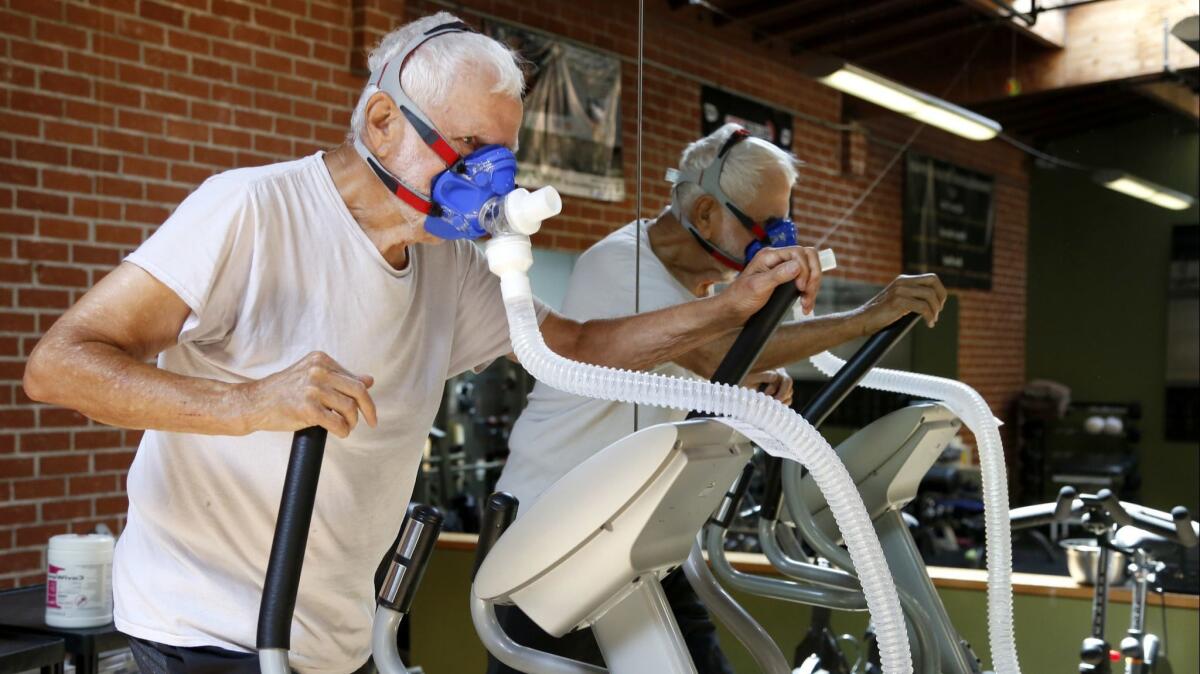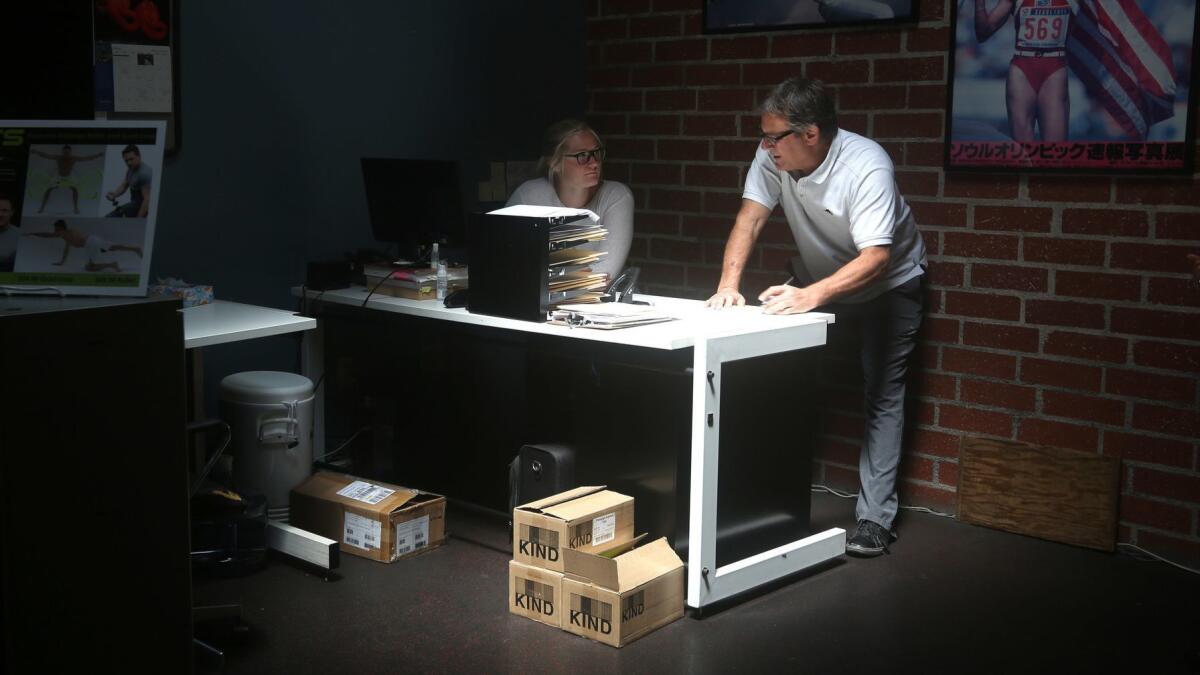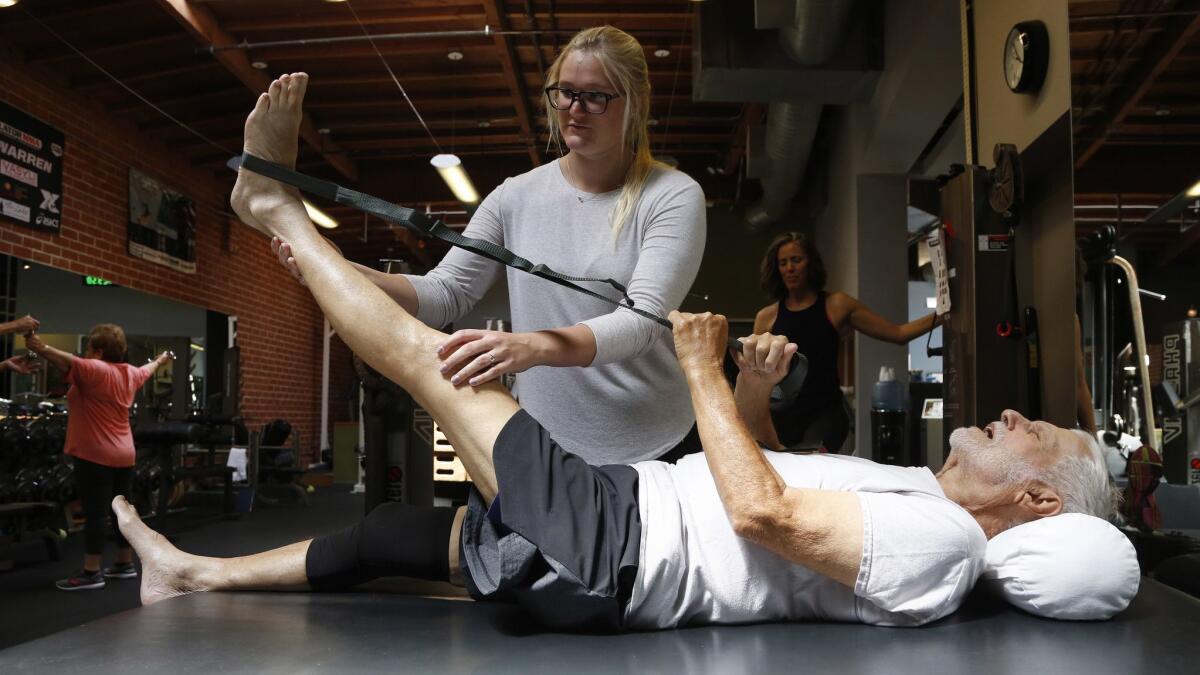How I got my 89-year-old dad to crush it in the gym
- Share via
“Exercise? I get plenty going to Costco for free samples.” For decades, my dad got a laugh with that line. But last year, as I watched him shuffle along with halting, rickety steps that barely cleared the ground, it wasn’t funny anymore.
Over the last few years, Norm Wallack, 89, of Lakewood, a retired aerospace engineer and grandfather of eight, had deteriorated from robust to doddering. The change was rapid and alarming. A slow 15-minute walk left him wasted. His neck and shoulders were so bent-over he appeared to be looking for coins. He seemed slower-witted too. Worst of all: placid acceptance of a future in physical decline.
I couldn’t accept it, though. My father had no disabilities and comes from a long line of centenarians. To me, the problem was obvious: his Easy Boy chair. Remote in hand, he hadn’t left it in 30 years (except for Costco and cleaning up in the backyard after the dogs).
So I made my pitch. Would he be willing to undergo a personally tailored and supervised regimen of diet and exercise — and allow me to report on the results?
Surprisingly, he listened. (Perhaps it helped that his older brother-in-law had just died after a decade of being spoon-fed in diapers.)
And he agreed.
Study after study touts the benefits of exercise for the elderly. “Movement is the best medicine,” says Robert Forster, a physical therapist who runs Phase IV, a training center in Santa Monica that works with many senior clients, and where I turned to for help. “No matter your age, exercise can cause significant muscle and cardiovascular remodeling in just three weeks. The trick is making the exercise habit stick — and for that, you need more time.”
Could we “resuscitate” Dad with exercise, make it part of his lifestyle and set him up for a decade or more of quality life? We were going to find out. In June, Forster put together an eight-week program that called for six days a week of alternating strength and aerobic workouts plus daily stretching. We added a Sunday super-stretch session with a “flexologist” at StretchLab, a hot new recovery alternative to massage. To make it scientific, we got before-and-after data on heart rate, VO2 max and BMI from Phase IV and detailed blood panels from WellnessFX, a biometric data service that includes a 30-minute phone consultation with a doctor.
The program started with a full-body evaluation at the Phase IV training facility. It was the official dose of reality that my father needed.

Dad strapped a mask over his nose and mouth. He pumped the elliptical machine. His gasping breath traveled through a long, white hose to a computer. This was a VO2 Max test, the gold standard of cardiovascular fitness. It measures the maximum volume (V) of oxygen (O2) that your body can process. The fitter you are, the higher the volume.
A top Tour de France rider has a VO2 Max of 85-to-90 milliliter per minute, per kilogram. Average fit men have 50-plus; sedentary men 35 to 40. In one study, inactive senior men ages 80 and older averaged 21.
Dad’s VO2 max was 12.
No wonder a 1-mph shuffle left him winded. His heart, lungs and entire oxygen-processing infrastructure had practically withered away. His extremely weak muscles and a slumped posture restricted his breathing, shortened his height by 3 inches and made him wobbly. Forster worried he was at risk of falling, often a life-changing experience for seniors.
In his blood, the Wellness FX analysis spotted the most pressing problems: poor kidney function and high blood sugar, for which he was taking meds. Fortunately, an exercise and diet plan can help both. Wellness FX consultant Dr. Nicholas J. Abram and the Phase IV team advised him to replace his morning oatmeal, breads and refined grains (ill-advised for high blood sugar, they said) with green vegetables, good fats like avocados, and protein (to build muscle).

Next up: A gym membership for $19 a month at Crunch, where my sister Cindy and I would supervise his workouts.
At the gym, Dad was a stranger in a strange land. Everything — machines and exercises — was new to him. Lat pull? Ab crunch? What’s that? The elliptical confused him. Still moving slowly, he had trouble navigating the different machines. Workouts lasted three times as long as normal. And being as much as 70 years older than other gym-goers, he felt like he didn’t fit in. “They’re tattooed head-to-toe and look they like they just got out of prison,” he said.
One benefit of starting at zero is fast progress. Day 1 on the elliptical, he lasted just 5 minutes at Level 1. By Day 28, he was up to two 15-minute sessions at Level 3, with a PR (personal record) of 78 calories burned. He set two new PRs on Day 42 with separate sessions: 15 min./83 cal. at Level 4 and 25 min./135 cal. at Level 5.
Same story with the strength workouts. He raised the weight from 10 to 50 pounds on a 10-rep chest press workout.
The biggest challenge was changing his attitude. A month in, he wasn’t happy. As I pushed him, he’d sometimes lash out, saying he was doing me a favor.
“Now I don’t have time to watch the stock market, go shopping ... and get my nap!” he yelled one day. I replied that he was wrong. He obviously does get a nap, since he says he always falls asleep after a workout.
The breakthrough came on Week 7, during a 30-minute session at his beloved StretchLab (beloved because he just lies there and gets worked on). I was looking on as his favorite flexologist, Karyl Sands, asked if the workouts were working.
“Yeah, I’m much stronger — and I know now that I need to do this,” he said.
She looked over at me.
I looked at her.
Did he just say need?

What a relief. A mind-set change was the key. In the end, if he did not see exercise as necessary for quality of life, this experiment was a failure.
The final results — improved cardio conditioning, weight loss and lowered blood sugar — were undeniable.
“That’s impressive,” an ecstatic Forster told my dad. “Your metabolic machinery is way stronger — you can do a lot more work with less effort.”
(His low kidney function, however, did not improve. Dr. Abram felt it might later as Dad’s body gets used to the extra stresses of exercise and hydrates more.)
As we left, Forster patted Dad on the back. “Good job! Most aspects of aging are just disuse. So keep moving.”
Dad says he will.
And so far, he has. “I don’t feel like Superman, but it worked,” he said of the experiment. “Exercise at this age is boring and hard to do without being pushed. I didn’t want to do it until I began to feel better after six or seven weeks.”
Now Dad walks 30 minutes at a brisk pace several times a week — with his head up. “I make an effort to move faster and straighten my back,” he says. “Everyone says I look better due to the posture and weight loss. I like that.”
He is still going to Crunch nearly every day and continues to see improvements. He no longer takes medication to control his blood sugar.
And he has a new joke he likes to tell: “Funny thing: When I tell other old folks what I’m doing, they think it’s foolish. One guy said, ‘That’ll kill you.’ He died last week.”
THE RESULTS
Eight weeks after Dad began, Wellness FX did another blood analysis. The dramatic results:
--His A1C — the three-month average of blood sugar levels — had dropped from 6.8 to 5.6. He was no longer in the diabetic danger zone.
--His VO2 Max rose from 12 to 14.2 — a 19% jump.
--His heart was stronger. When he started, his heart rate hit 105 bpm after just one minute of exercise. Eight weeks later, it was 94 bpm, a sign of improving cardio fitness.
--His endurance more than doubled. When he started, he lasted just three minutes at Level 1 on the elliptical. Eight weeks later, he lasted six minutes at Level 4.
--9-pound weight loss. His BMI dropped from 26.6 to 25.2.
READ ON!
Yes, you can eat your way to beautiful skin
10 high-tech gadgets to help you get to sleep
How ‘Scandal’s’ Katie Lowes hid her psoriasis
7 steps to making your health your No. 1 priority
He lost 84 pounds in four months — and kept it off






